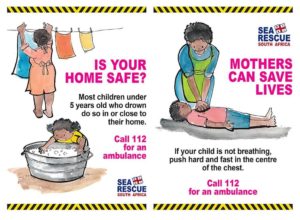Drowning is a leading cause of death in toddlers. The places that toddlers face the greatest danger from water is in, and near to their home.
Children can drown in only a few centimetres of water which is why anything from backyard swimming pools to bathtubs and buckets pose a great risk.
The National Sea Rescue Institute (NSRI) is urging parents and caregivers to ensure that their homes are water safe.
According to Statistics South Africa, fatal drowning is the 5th leading cause of unintentional death in the country with an estimated 350 children who die by drowning in each year.
May 15 was International Water Safety Day and this year, the NSRI is spreading awareness of the ongoing drowning pandemic in South Africa and is focusing on educating the youth in becoming safer in and around water through their school water safety program.
“Most drownings of children under five years of age are at, or near, their home. Special attention should be paid to washing basins, baths, dams, rivers and swimming pools. Small children should not be able to get close to these dangers alone without responsible adult supervision. Older children should also be reminded of the dangers that they face near water,” said Andrew Ingram, Drowning Prevention Manager for the NSRI.
The World Health Organisation suggests four interventions that will protect children from drowning:
- Install barriers controlling access to water
- Provide safe places away from water for pre-school children, with capable child care;
- Teach school age children water safety and swimming skills and;
- Train bystanders in safe rescue and resuscitation.

Lessons in water safety
Sea Rescue’s Water Safety Instructors prevent drowning tragedies through education.
Their lessons are focused on children from disadvantaged communities, where access to water safety information is limited and the need is great. These are the children who are most likely to drown. Their water safety lesson fits into a school period and teaches children to be safe in and around water in fun, interactive lessons.
They have taught almost 3 million children how to avoid dangers in or near water, what to do in an emergency, who to call for help, how to rescue a friend, and finally, how to do hands-on CPR. The lesson is given at schools at no charge and during lock down, NSRI instructors conducted virtual lessons. Schools and creches are encouraged to reach out to the NSRI to arrange for lessons to be given in their area.
Prevention is key when it comes to water safety.
“It is vital that parents and caregivers have knowledge of first aid and CPR, that they save their local emergency numbers in their phone and make sure that their family members and children’s caregivers do the same”, added Ingram.
In case of an emergency, call 112 from a cell phone or a landline.
You can help the NSRI save lives by donating to their water safety programmes in schools at www.nsri.org.za/donate


